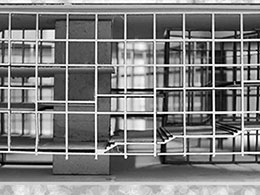STUDENTS PROJECTS
PROJECTS2015
Students : Vertha Grypari, Nefeli Papayanni
Supervisor : Kostis Paniyiris
University of Thessaly
Presentation date : 2015
ABSTRACT
The subject of our study was the design of an Architecture School. The site is located in the city center, so it can interact with the public space. Basic morphological elements of the building design were the ramps, aiming to the penetration of the movement of the city, into the building (which can be regarded as a continuation of the city) and the shell which follows the boundaries of the site and it is characterized by a high level of transparency and drilling.
FOREWORD Seeking to redefine the urban terrain and its relationship to the buildings, but also with public spaces of a city, our initial goal was to create a building, which would strengthen that relationship. The area of study was chosen to be the city center of Ioannina that presents all the characteristics of a Modern Greek city, which combines the intense urban life and activity with elements of historical interest, but also with a specific natural landscape. Therefore, our thought was led to the realization of an Architecture University School, which meets the criteria that were set.

INTRODUCTION The characteristics of Ioannina, a city in western Greece, studied in such a way as to take into account the building design process. Specifically the selected plot, located on the junction between the streets Zosimadon, P. Fereou, Tsirigoti, Ad. Korai and Dagli, where there is the abandoned building of the old Bus Station and is a central point which is directly related to the intense urban life (purchase, recreation, etc.), the historic center, and it is in a walking distance from Lake Pamvotis.
The strategy of the building was based on certain guidelines, focusing on how the experiences are affected by the configuration of the space. Initially a direct relationship , was sought, with the movement of the city of Ioannina, as this is essential both for students and for teachers of the school. However, due to this interrelationship, the study of the building was implemented in such a way that it contributes to the public place in the city. Taking as reference the work of Giovanni Battista Piranesi, the ground of the city rises gradually and perimeter to the plot, smoothing the way of penetration in it, while, creates a visual game of ramps at different heights. Also, the design of the building shell, was approached by the conceptualization as open "hinge" between city life and the program of architecture, with a strong element of transparency, and punching. Another direction was on the complexity of the configuration of the interiors based on the functions, deepening the parallelism of events, which is transferred to a draft.
IDEA Specifically, the city of Ioannina, displays such features as the above, as it presents mix of uses particularly in its center. There is coexistence of commercial spaces, leisure, services, education, housing, and historical sites and monuments. Simultaneously, there are presented numerous urban voids because of the abandoned building infrastructure, thereby a special condition of experiencing the city's public space is created. Initial concerns were the redefinition of the public space, as well as the penetration of the city within the structures. In addition, studying the existing multifunctional planning system, it is sought to create a feed core of the network, while it is important to redefine the concept of "habitation". So it was selected for the realization of this core, the creation of the building of the Architecture, considering that responds to our initial concerns.
OPERATION With regard to the operation of the building, there is diffusion of functions, following the city's program. Mobility becomes intensive through the various parallel events, which creates a direct interface between teachers and students, and also students between each other, so a form of symbiosis is negotiated. Another element which is part of the program is the special function of the corridors, which operate as stations, forming a link between levels. A characteristic feature of an Architecture School is the intensive work in the corridors. Thereby, they were designed by including plug-in points. Furthermore, the program includes extra uses, such as oases, as places of rest and brake from work, and also exhibitions' space as a highlight of students' work. The configuration of the ground level is a result of the need of the city's penetration into the building, either with the form of a passage, or that of a square. Another element that strengthens this relationship, is the placement of exhibitions to convey a representative image of the department to the public. Mobility through the building is being carried out by two ways. The first is about the round movement, while the second is the vertical. With regard to the first, it starts from the ground floor and includes a cafeteria, continuing with the first placed offices and rooms, and then there is the library and reading room. Then a series of desks and drawing boards, exhibition space, offices, halls and the space of oases follows, ending to the art hall and the relevant offices. Additionally, the amphitheater is placed in the basement, in conjunction with the relevant offices, while at the end of the upstroke, there is a balcony. The vertical movement includes elevator and staircases, which are placed in the two diametrically opposite levels of the building.



















